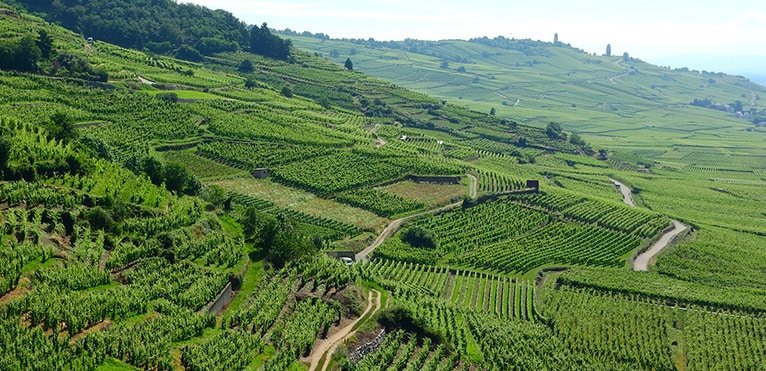
Contents
Riesling is considered one of the king wines of Alsace. It is sometimes even considered the best white wine in France. Its region of origin, Alsace, is a historic and world-renowned wine-growing region. In fact, each year around 1,200,000 hectolitres of wine are produced in the region’s nine Appellations d’Origine Contrôlée (AOC).
The area is over 120 kilometers long, sometimes hilly around the Vosges mountains, sometimes flat. Riesling has been awarded the AOC and AOP (Appellation d’Origine Protégée) labels.
Riesling is a recently rediscovered wine
While historians believe that the origins of Riesling date back to Antiquity, the first real traces of the king of white wines only date back to the Middle Ages. Its cultivation was relatively timid at the time, due to low yields and the demands of the grape variety.
Nevertheless, from the post-World War II period onwards, the upmarket development of Alsace’s vineyards has been accompanied by the replacement of traditional grape varieties by so-called noble varieties, including Riesling B. These efforts by Alsace’s winegrowers led to the creation of the appellation “Alsace wine.
Riesling benefits from optimal conditions
Riesling is mostly grown and vinified at altitudes ranging from 200 to 400 meters on steep plots of Vosges hillsides, where the soil is mainly composed of plutonic rocks such as granite, gneiss and slate. The lower, less sloping plots benefit from a more calcareous soil, composed of alluvial deposits washed down by the Rhine. Whether plutonic or limestone, these rocks are ideal for vine drainage. Indeed, their porosity prevents water stagnation and they contribute mineral elements to the vines as they erode.
In addition, the climatic conditions enjoyed by the Riesling plots are ideal. The climate is generally dry and continental. Alsace is one of France’s driest wine-growing regions. The sunshine is more than adequate, so the 3,376 hectares of Riesling vines flourish.
Riesling is renowned for the intensity of its aromatic palette.
Alsace Riesling is a single-varietal wine, i.e. its Charter requires the use of a single grape variety during vinification. In this case, the grape variety used is Riesling B. In a sunny environment such as the one described above, budburst and ripening are late, so the harvest doesn’t take place until mid-October. Finally, this variety is particularly resistant to frost.
To the eye, Riesling displays a clear, sparkling golden color with green highlights in its youth. As it matures, it gains a warm, golden color. On the nose, it initially reveals a delicate bouquet reminiscent of lime blossom and peach blossom, as well as more subtle fruity notes of apple and citrus fruits such as grapefruit and mandarin. You can also distinguish aromas typically associated with wine fermentation, such as breadcrumbs and brioche. These are generally more subtle, fermentative aromas. The finest noses will even detect notes of chalk or flint.
Indeed, as it ages, Riesling reveals more mineral aromas. On the palate, Riesling generally has a broad, well-rounded attack, meaning that its aromas fill the palate cleanly. However, this description needs to be qualified: Riesling B is a very plastic grape variety, and therefore releases a wide range of aromas depending on the winemaking conditions. This is a wine full of pleasant surprises.
In general, we recommend keeping a bottle of Riesling between 3 and 15 years. However, if it’s a Riesling Vendanges Tardives, it’s advisable to keep it between 5 and 20 years.
Riesling available as dry, sweet or syrupy wine
Riesling is generally a dry wine. Nevertheless, the plasticity of the grape variety used makes it possible to obtain mellow or even sweet Riesling. It’s best to make sure you know what it says on the label, so as not to be surprised. In any case, it will remain drier than its Alsatian counterpart, Gewurztraminer.
So, as expected, Riesling goes very well with traditional Alsatian cuisine. It’s a perfect match for sauerkraut, for example.
In addition, Riesling is renowned for enhancing iodized flavors such as fish and seafood. Special mention should be made of raw fish: nothing goes better with a sushi platter than Riesling.
Riesling is generally served between 8 and 10°C. It’s important not to serve it chilled, as this may exacerbate its acidity and cover up its more subtle aromas.
Numerous quality vintages for AOC Riesling
Riesling has several denominations, including Grand Cru d’Alsace. Alsace has 34 for Riesling. The terms “Vendanges Tardives” and “Sélection de Grains Nobles” are also used. The years considered as exceptional vintages for Riesling are : 1947, 1953, 1969, 1981, 1985, 1988 and 1990.
Family-run estates committed to organic farming make the Riesling AOC famous
Bott Geyl Estate
Wine has been flowing through the veins of the Bott family since 1775. This family-run estate has taken it to heart to develop their winemaking methods with man. As humanists at heart, this family is as committed to local politics as it is to maintaining the authenticity and preserving the quality of their wine. In this respect, the estate is committed to organic and biodynamic farming, using natural fertilizers adapted to the needs of the vine. Covering more than 15 hectares and touching the terroirs of seven communes, the estate’s headquarters are in Beblenheim.
Valentin Zusslin & Sons
Since 1691, generations of Riesling winemakers have strived to pay homage to the work of their ancestors by preserving the quality of Alsace’s vineyards and engaging in contemporary causes. Located in the commune of Orschwihr, not far from Colmar, Domaine Zusslin cultivates 16 hectares of vines on three distinct terroirs: the slopes of the Bollenberg, Clos Liebenberg and Grand Cru Pfingstberg. This characteristic enables them to develop a very interesting variety of wine. Since 1997, the Zusslin estate has been run entirely according to biodynamic principles. It also has the Agriculture Biologique label.